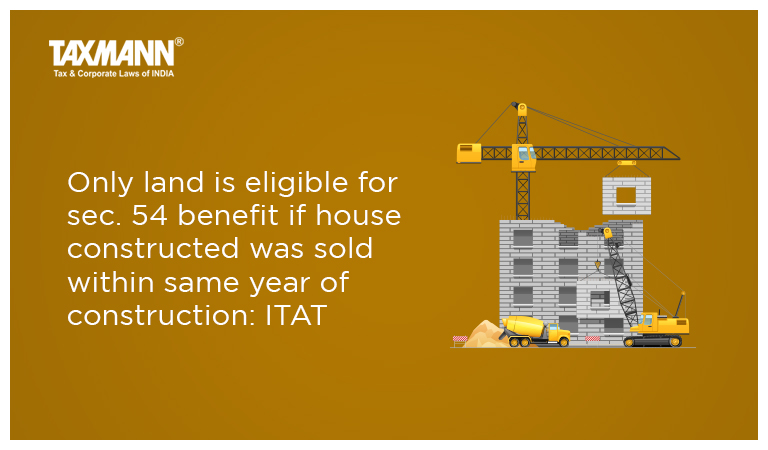Only land is eligible for sec. 54 benefit if house constructed was sold within same year of construction: ITAT
- Blog|News|Income Tax|
- 2 Min Read
- By Taxmann
- |
- Last Updated on 5 August, 2022
Case Details: Smt. Seema Shah v. ITO - [2022] 140 taxmann.com 523 (Varanasi-Trib)
Judiciary and Counsel Details
-
- Vijay Pal Rao, Judicial Member & Ramit Kochar, Accountant Member
- A.K. Singh, Sr. DR for the Respondent.
Facts of the Case
Assessee was owner of land purchased in the financial year 2006-07. She had also constructed a house on said land in the financial year 2013-14. The assessee sold said land along with one part of a house constructed upon it in the same financial year 2013-14.
She invested sale consideration in the purchase of new residential house and claimed exemption under section 54. However, Assessing Officer (AO) was of the view that the building was sold in same year of its construction. Thus, the capital gain that arose on its sale was short-term capital gain not eligible for section 54 relief.
On appeal, the Commissioner (Appeals) also upheld the order of AO. Aggrieved-assessee filed the instant appeal before the ITAT.
ITAT Held
The Tribunal held that the residential house which was constructed by the assessee on the said land was constructed in the financial year 2013-14 and sold the same financial year 2013-14 itself. Thus, the AO had rightly classified the gains arising from the sale of house as short-term capital gains.
The language of section 54 is clear, plain, and unambiguous and the benefit under section 54 can only be allowed on long-term capital gains earned by the assessee.
The asset sold was composite being land and residential house constructed by the assessee. Hence, the claim of section 54 shall be restricted to long-term capital gains arising on sale of land being long-term capital asset. The residential house constructed on the said land cannot be considered for grant of deduction under section 54, being a short-term capital asset.
Thus, apportionment between land and building was required to be done and exemption under section 54 was to be allowed on long-term capital gains realized on sale of land only.
List of Cases Referred to
-
- C.N. Anantharam v. Asstt. CIT [2015] 55 taxmann.com 282/230 Taxman 34 (Kar.) (para 5)
- CIT v. Dr. DL Ramachandra Rao [1999] 236 ITR 51 (Mad.) (para 5)
- CIT v. Vimal Chand Golecha [1993] 201 ITR 442 (Raj.) (para 5)
- CIT v. C.R. Subramanian [2000] 242 ITR 342 (Kar.) (para 5).
Disclaimer: The content/information published on the website is only for general information of the user and shall not be construed as legal advice. While the Taxmann has exercised reasonable efforts to ensure the veracity of information/content published, Taxmann shall be under no liability in any manner whatsoever for incorrect information, if any.

Taxmann Publications has a dedicated in-house Research & Editorial Team. This team consists of a team of Chartered Accountants, Company Secretaries, and Lawyers. This team works under the guidance and supervision of editor-in-chief Mr Rakesh Bhargava.
The Research and Editorial Team is responsible for developing reliable and accurate content for the readers. The team follows the six-sigma approach to achieve the benchmark of zero error in its publications and research platforms. The team ensures that the following publication guidelines are thoroughly followed while developing the content:
- The statutory material is obtained only from the authorized and reliable sources
- All the latest developments in the judicial and legislative fields are covered
- Prepare the analytical write-ups on current, controversial, and important issues to help the readers to understand the concept and its implications
- Every content published by Taxmann is complete, accurate and lucid
- All evidence-based statements are supported with proper reference to Section, Circular No., Notification No. or citations
- The golden rules of grammar, style and consistency are thoroughly followed
- Font and size that’s easy to read and remain consistent across all imprint and digital publications are applied








 CA | CS | CMA
CA | CS | CMA


